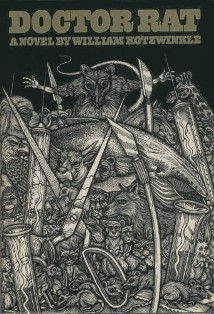
First Published back in May of 1976, US novelist William Kotzwinkle’s twelfth novel ‘Doctor Rat’ is perhaps the author’s best known publication outside of his novelisation and screenplay for ‘E.T. The Extra-Terrestrial’ (1982). The novel was well-received by critics and the general public alike, winning the World Fantasy Award for Best Novel in 1977.
DLS Synopsis:
Doctor Rat has been driven quite insane during his time in the university research laboratory. He knows it. And he wholeheartedly embraces the madness. After all, he is the self-dubbed Mad Doctor. Driven insane from continuously running the maze set down by the research scientists, the mad test-rat has much to say on the matter of his and his fellow test subjects’ predicament.
Castrated at birth, Doctor Rat spends his days amongst the various other animals in the laboratory, ranting about the absolute necessity of the experiments being performed here. A whole host of different species are locked up alongside the mad Doctor Rat, each one there is undergoing their own atrocious experiment in the name of science.
And it’s the justification for these horrific experiments that has captivated our maniacal Mad Doctor. It’s all for the greater good of validating the facts of past experiments. It’s necessary for national defence. It’s necessary in order to secure further grants for the continuation of the testing. It’s all necessary. And so he accepts his and every other animal in the laboratory’s fate at the hands of the scientists and academic scholars.
But when a new test subject arrives on the scene, a stray dog brought in to evaluate the symptoms and consequences of extreme heatstroke, whisperings of an uprising is in the air. Regardless of Doctor Rat’s animated shouts declaring “Death is freedom” a revolution is slowly forming.
They are on the verge of something great. A gathering to form ‘One Animal’. To stand tall against humankind’s callous acts upon the entire animal kingdom. To stand up and fight back, the world over. To come together and end the animal kingdom’s seemingly endless suffering...
DLS Review:
Darkly satirical, with numerous splattering of maniacal wit, Kotzwinkle’s story of scientific animal testing taken to outlandishly morbid degrees was a particularly poignant subject matter at its time of publication in the 1970’s. The combination of visceral scenes of brazen animal torture with lashings of black-comedy made for an altogether gut-twisting and chillingly guilt-inducing read. That is, when you’re not laughing out loud at the insane Doctor Rat’s rantings (it seems so utterly wrong to say)!
Having much of the tale narrated by the excitable Doctor Rat makes for an instantly engaging and entertaining read. The mad rat’s outbursts, rantings and meandering thoughts create a brilliantly scattered dissection of the distasteful events taking place within the laboratory.
At various points throughout the length of the novel, Kotzwinkle leaves the Doctor Rat narration and instead jumps between the perspective of a variety of fellow test subjects, or animals around the world responding to the calls for an uprising. This helps to expand the tale out from just the somewhat confined premise of Doctor Rat’s isolated world alone, and helps to create the much bigger picture that the author is gradually attempting to achieve.
The morbid acts of cruel experimentation that are being performed on the various test subjects within the laboratory are detailed in a wealth of visceral glory, setting a jagged tone to the otherwise comical bombardment of witty insanity. Like an exaggerated and somewhat twisted comparison to the laughably obscure meanderings within Joseph Heller’s ‘Catch-22’ (1961), Kotzwinkle’s ‘Doctor Rat’ takes its audience on an entertainingly surreal route through an overwhelmingly disillusioned viewpoint.
The madness and resulting animal uprising escalates, with the insane Doctor Rat being the only creature standing against the revolution. However, the actual endgame for the novel seems to spiral out of control, with Kotzwinkle’s ambitious imaginings never really managing to be successfully portrayed to the extent that he no doubt envisaged.
The finale is intriguing and compelling in the desire to know how the author will play out the ending, and indeed how humankind will fair in the ultimate decision. Kotzwinkle knows how to play a final card and how to captivate his audience with a dramatic finale. On some levels this works well for the novel, keeping the reader guessing and glued to the progression of the tale. However, you can’t help but feel that Kotzwinkle has missed out on a larger piece of the whole thought-provoking jigsaw. The very essence and backbone of the book’s underlying message around mankind’s cruelty and lack of respect for all other species is stuttered rather than shouted. A trick has certainly been missed along the way. The impact is too fragmented to really hit home well enough. And so the overriding message seems to somewhat peter out amongst the various mad rantings and dubious bestial uprising.
The novel runs for a total of 243 pages.

© DLS Reviews






